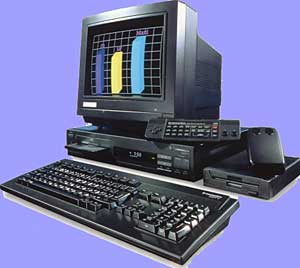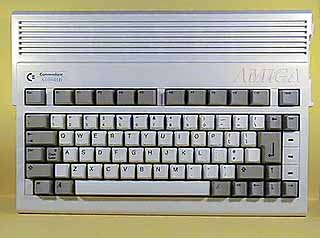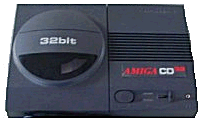 Amiga in the 90s: The
CDTV was a stylish, black CD-based machine (see picture). Basically an A500, the machine failed to sell
well.
Amiga in the 90s: The
CDTV was a stylish, black CD-based machine (see picture). Basically an A500, the machine failed to sell
well.2. THE STORY
The story of the Amiga is a fantastic one. In the early 1980s, Jay Miner and Larry Kaplan (both ex-Atari) sought investors to create a powerful new computer. Three dentists invested large sums of money into the project. The company they formed was named Hi-Toro. The team that was hired to work on the project was a very talented one. In order to maintain secrecy about the real project (codenamed “Lorraine” after the CEO’s wife), Hi-Toro developed joysticks and other products for Atari. The name Amiga was adopted later the same year, as Jay Miner wanted a ‘friendly’ name.
Originally, the investors wanted to create a games machine based on the powerful Motorola 68000 processor, as used in arcade machines. Jay Miner always wanted to create a more all-round personal computer. The solution? I/O interrupts were covertly incorporated into the motherboard, thus allowing the later addition of a keyboard.
Although work was progressing, the company was losing money fast. In desperation, Amiga accepted a loan from Atari, with the condition that if not repaid in one month Atari would get the rights to the new technology. Commodore stepped in at the last minute, purchased Amiga and paid off the debt to Atari. Amiga now had the funding to complete their machine.
In 1985, the Amiga 1000 was launched. It was far in advance of the PCs and Macs of the time, with 256KB RAM, 4096 colours and proper multitasking.
The Amiga, although a great machine, was behind in sales to Atari’s cheaper ST. In 1987 Commodore released the Amiga 500. A great success, it won several Computer of the Year awards. The A2000 was also released as a machine for professional
use.
 Amiga in the 90s: The
CDTV was a stylish, black CD-based machine (see picture). Basically an A500, the machine failed to sell
well.
Amiga in the 90s: The
CDTV was a stylish, black CD-based machine (see picture). Basically an A500, the machine failed to sell
well.
 A new chipset: ECS (Enhanced Chip Set). Many models of Amiga were released in the next few years: A500 Plus,
A600 (see photo: no numeric pad), A2500, A3000…
A new chipset: ECS (Enhanced Chip Set). Many models of Amiga were released in the next few years: A500 Plus,
A600 (see photo: no numeric pad), A2500, A3000…
 An important innovation came in 1992. Incorporated into two new models, the A1200 and A4000, was the AGA chipset. With it, and products such as Lightwave and the Video Toaster, the Amiga enjoyed even more success in the field of film and television, a traditional strength. By 1993, however, Commodore was in financial trouble. The
CD32, a 32-bit AGA games console, was released. It was moderately successful, but not enough to save Commodore from bankruptcy in 1994.
An important innovation came in 1992. Incorporated into two new models, the A1200 and A4000, was the AGA chipset. With it, and products such as Lightwave and the Video Toaster, the Amiga enjoyed even more success in the field of film and television, a traditional strength. By 1993, however, Commodore was in financial trouble. The
CD32, a 32-bit AGA games console, was released. It was moderately successful, but not enough to save Commodore from bankruptcy in 1994.
Weak marketing was a major contributing factor in the collapse of Commodore. A sad time for the Amiga team, remembered in the ‘Deathbed Vigil’. The race was now on to save the Amiga from disappearing along with Commodore. In the ensuing bidding, the rights were acquired by German company Escom. Existing Amiga models were manufactured again, but despite concepts such as ‘Walker’ there were no new developments. Escom subsequently went into liquidation, leaving the Amiga without an owner again. In the second auction, Viscorp and Quikpak both made bids, but the eventual winner was US giant Gateway. Like Escom before them, Gateway failed to produce a new Amiga, only designs.
In late 1999, the Amiga passed into the hands of Amino, a company set up by ex-Gateway employee Bill McEwan.
And now? Amiga users wait for new hardware, in the form of PowerPC Amigas. There had been PowerPC cards made by phase5 that carried the Amiga up to today, but broke phase5. AmigaOne and Pegasos are the hope for the future. Amiga users love their platform above all others, illustrated by their loyalty even when the Amiga was a computer without a company. For them, it is better this way than the temptation of "comfort" offered by Microsoft.